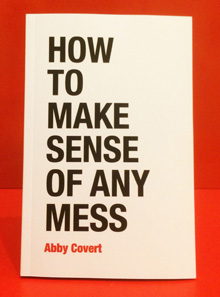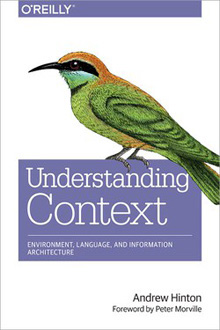Review Objectives
These book reviews represent my own opinions and encapsulate three things:
- The lasting impression the book left on me
- What audience would benefit most from reading the book
- The book’s relevance to the field of information architecture
I’m providing these reviews to help readers find books that may match their current interests or that might prove useful in working on a related project. I also hope to encourage people who already own these books to revisit some passages from them, perhaps looking at them through a new lens or prompting constructive debate.
How to Make Sense of Any Mess, by Abby Covert
 Abby Covert is the outgoing president of the Information Architecture Institute and founder of the very popular World IA Day. She is an independent consultant and tireless advocate for information architecture who still finds time to teach design and information architecture at Parsons School of Design: The New School.
Abby Covert is the outgoing president of the Information Architecture Institute and founder of the very popular World IA Day. She is an independent consultant and tireless advocate for information architecture who still finds time to teach design and information architecture at Parsons School of Design: The New School.
Lasting Impression
How to Make Sense of Any Mess, by Abby Covert, comprises a string of proverb-like recommendations for distilling complexity—or mess—into manageable chunks. This is a highly accessible read that does an impressive job of condensing each topic that it explores into a single page. The book takes you through seven essential steps:
- Identify the mess. This means preparing for an honest assessment of the complexity you’re dealing with. While this could be uncomfortable for you or your client, it’s a necessary step that will help you establish realistic objectives.
- State your intent. Mean what you say—understanding what you mean as you explore who, why, and what.
- Face reality. Be sure to frame the scope, context, and constraints of an engagement and provide visual maps to give clarity.
- Choose a direction. Decide on a strategic path and explore it by considering meaningful relationships between objects, people, and places.
- Measure the distance. Define goals so you can measure success. Set indicators to help you stay on course and reach your goals.
- Play with structure. Use taxonomy, facets, and other organizing principles to reduce ambiguity.
- Prepare to adjust. Abby says this best: “Be the one not bringing the ideas. Instead, be the filter that other people’s ideas go through to become drinkable.”
Likely Audience: UX Professionals and IA Practitioners
How to Make Sense of Any Mess doesn’t go deeply into any one area. This helps to keep the subject matter light. And while the discussion never gets too technical, Abby still keeps the reader connected to information architecture at a meaningful level. IA practitioners at all levels will benefit greatly from reading this book.
Relevance to Information Architecture
How to Make Sense of Any Mess introduces a thoughtful lexicon of terms that are worthy of scrutiny. Debating the merits of the book’s terminology could engender a healthy discourse about the curation of industry terms and concepts. While the book’s content strategy is modest, as the author intended, How to Make Sense of Any Mess is without a doubt an ideal book from which to transition to a deeper IA conversation.
Finally, you won’t find an argument for why companies should hire expert IA practitioners in this book. You’ll have to figure that out on your own. But that’s okay. The value of this book rests in its goals:
- helping anyone simplify the complexity of making decisions about information architecture
- giving the practice of information architecture the credit for building a professional discipline around the need to make such decisions
My Endorsement
How to Make Sense of Any Mess is a solid primer on the approaches information architects use in breaking down information complexity. If the subject of information architecture were a building, this book would be its front door. All are welcome.
 Andrew Hinton is a founder of the Information Architecture Institute and has helped to frame how we discuss information architecture for more than 15 years. Andrew is a respected voice in the IA community and often shares his research and thought leadership at the IA Summit and World IA Day.
Andrew Hinton is a founder of the Information Architecture Institute and has helped to frame how we discuss information architecture for more than 15 years. Andrew is a respected voice in the IA community and often shares his research and thought leadership at the IA Summit and World IA Day. 